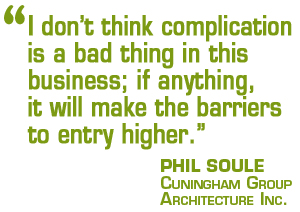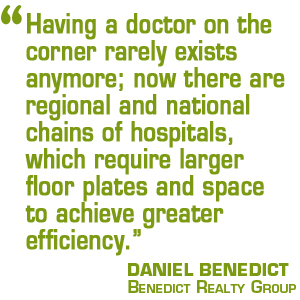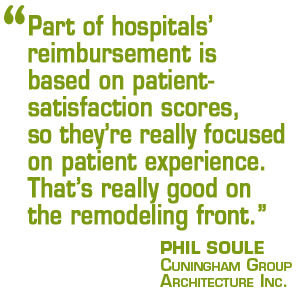This is the web version of a feature that originally appeared in Real Estate Forum magazine. To see the story in its original format, click here.
The aging US population, combined with a shift toward patient-focused service delivery, has been a main growth driver in the nation's healthcare industry, according to a recent medical-office outlook from Marcus & Millichap. The firm's national director of specialty divisions, Alan Pontius says, “As the 65-and-older age segment is projected to grow by 20 million individuals over the next 10 years, demand for healthcare services will rise.”
In healthcare real estate especially, demographics is a huge driver. At December's RealShare Healthcare Real Estate conference in Scottsdale, AZ, panelist Darryl Freling, managing principal of MedProperties Holding LLC, said the one constant in the healthcare business is the aging demographics and the growth of service in the sector. “Underwriting healthcare tenants and the business model has always been complicated, so what I am hearing today is that the industry is sound, demographic drivers haven't changed, the election will have an impact on the business model for the delivery of healthcare, but the underwriting and business model for providers is already complicated and it will continue to be that way. I don't think complication is a bad thing in this business; if anything, it will make the barriers to entry higher.”
Complicated underwriting processes don't necessarily jibe well with the increased demand on the healthcare system that the Affordable Care Act has spurred. “America is aging, and therefore using the medical profession more, so there's greater demand,” says Daniel Benedict, founder and president of NYC-based Benedict Realty Group. “More people are insured, and the days of the small medical office are essentially over. Having a doctor on the corner rarely exists anymore; now there are regional and national chains of hospitals and they require larger floor plates and space to achieve greater efficiency.”
While the senior generation is having a huge impact on the growth of the industry, Pontius notes that the Millennial generation is driving a major shift in the care delivery model. Millennials want quick access to physicians, he says, adding that they also prefer transparency from providers and insurance companies.
Millennials also like the advances in technology that enable them to shop online for doctors, research treatment options and web-based diagnostic health tracking tools, Pontius adds. “Those are placing a wealth of knowledge and information about personal care into the hands of the patient.”
As the need for healthcare facilities has increased, so has investor demand for this category. In the fourth quarter of 2016, BRG closed on a $60 million, 12-building, medical-office portfolio spanning 350,000 square feet in Providence, RI. At the time, the firm had indicated that it wanted to expand its holdings in the sector. Including the acquisition, the firm now holds 17 MOBs and over 600,000 square feet on the East Coast.
Benedict told GlobeSt.com at the time that the firm's future plans include purchasing $200 million of medical office properties near top-tier medical institutions along the East Coast, where the demand for medical office properties is greater than in other parts of the country and where BRG knows the market.
Benedict isn't the only one bullish on the sector. Capital One's annual survey of healthcare leaders recently found that merger and acquisition activity is once again expected to be the industry's preferred growth strategy in the year ahead. However, nearly one in three executives (31%) plan to drive growth by launching new segments or lines of business—a jump from 17% last year. Thirty-eight percent of respondents said that M&A transactions would drive their growth plans in 2017—down 3% from 2016—and more than a quarter of respondents (26%) pointed to organic growth initiatives as their top growth strategy. And nearly half of those surveyed (42%) expect their capital needs to rise in 2017, a sharp rise from 25% in last year's survey.
In addition, the consensus among speakers and attendees at RealShare Healthcare Real Estate was that as far investment goes, the sector is a great place to be. Panelist David Lynn, CEO and chairman of Everest Medical Core Properties, said that, relative to office, healthcare is still a relatively inexpensive asset class. But he noted that it isn't priced as efficiently as office because it isn't widely traded. “We still have room to compress in medical office.”
And it isn't just medical office that's in demand. Urgent and acute care centers, retail clinics and standalone emergency departments are replacing primary care physicians and hospital emergency rooms as this generation strives for more efficient and affordable healthcare options, Pontius says.
As healthcare continues changing, providers are continuing to seek ways to cut costs. According to a recent GlobeSt.com article, there has been a flood of construction as major hospital systems create a new ecosystem of clinics and ambulatory centers that can provide more efficient care. And regardless of any changes which occur in the provision of health insurance, experts say these trends will continue in 2017, and keep developers in the sector very busy.
Manish H. Shah, who just recently joined KTGY Architecture + Planning as executive director, says the transformation of the healthcare sector reminds him of how the world of retail has evolved out of a need to cut costs and compete with e-commerce. Shah, who leads KTGY's growing healthcare design practice, recalled a time when everybody wanted to go to malls, “and downtowns across the country died out,” he says. But sometime in the 1990s, the big-mall concept began to fade and developers started concentrating on smaller lifestyle centers and stores. “Healthcare is going through something similar.”
Shah says that instead of giant, centralized hospitals, providers are moving most preventative-care services, including primary care physicians, off-site into medical-office buildings or clinics. The main hospital in any system can then concentrate on providing the more expensive specialist care.
“There was a time when you had to go to a hospital to get a simple MRI,” Shah adds. Today, though, a patient is more likely to have such a procedure done in an off-site clinic. Furthermore, new immediate-care centers, also dispersed across a wider area, have cut down on visits to hospital emergency rooms, typically a tremendous expense for healthcare systems.
RealShare panelist John Pollock, COO of Meridian, said that this “retailization” of healthcare is about visibility and is here to stay. “I don't think it is a fad,” he said, adding that in some markets, though, it's untenable in terms of cost and rents.
And panelist Gino Lollio, VP of investment at Marcus & Millichap, said it's really about convenience, cost and time for the operator and the patient. If you can bring the services to patients' daily commuting paths and get them in and out, then it works, he said. “The other benefit of this trend is that it takes the pressure off emergency rooms.”
But the need for efficiency also means that providers want to occupy less real estate overall, and that presents a challenge to designers, says KTGY's Shah. “At some point, they come to us and say, 'How can we do this?'”
One response has been consolidating some of the care now provided through clinics into one space. For example, Shah helped design Sinai Community Institute's new clinic for women on the west side of Chicago. It will provide obstetrics, gynecology and mammography services, but “we don't have three distinct clinics,” he says. “They are all connected and open.”
The designers did, however, utilize subtle methods, such as different color schemes and finishes, to distinguish how providers use the space, he said. Construction will begin in April.
Likewise, Phil Soule, designer and principal of Cuningham Group Architecture Inc., notes that a few of the latest trends in hospital design he sees are more focused on outpatient and emergency departments.
“Primarily, what the hospitals are seeing is that the physicians won't take ACA insurance, and EDs are required to, so many of the people who are on that brand of insurance are slamming EDs,” Soule says. “It's interesting because the goal of the whole thing was to move patients out of the acute-care setting. That's a huge trend. Also, part of hospitals' reimbursement is based on patient-satisfaction scores, so they're really focused on the patient experience. That's really good for us on the remodeling front.”
According to Pontius, the design of medical office space has been impacted in recent years as builders conform to the standards of a patient-centered approach to healthcare and advances in technology. “Large healthcare providers are acquiring and expanding services off campus and closer to residential areas, providing easier access to care.” He adds that this has prompted the development of ambulatory surgery centers, standalone emergency rooms and large multi-tenant medical office buildings.
“As the way people seek medical care and approach care changes, developers must keep up by offering flexible designs and cost-cutting amenities,” Pontius says. “Medical-office absorption over the past five years has been concentrated in buildings constructed since 2000, and constricting vacancy at these properties will drive additional deliveries this year.”
As for what hospitals need most from renovations today, Soule says some healthcare decisions like orthopedic and having a baby are marketing-based decisions. “People will check out facilities and choose where they want to go, so these facilities are having to keep up with each other in terms of quality of space as well as quality of staff in those service lines particularly,” he says. “Healthcare delivery decisions are most commonly made by a mom, so if mom has a great experience having a baby in one facility, the family tends to stay with that hospital. They spend a lot of money on labor and delivery and tours for that reason.”
Of course, with President Trump's promise to repeal and replace the ACA, more uncertainty and the potential for more change have been thrown into the mix. KTGY's Shah has a wait-and-see attitude toward a possible repeal of the ACA and says whatever happens, it will probably take several years to sort out. But many health-insurance policies will still have high deductibles, and that will help lead providers to continue redesigning the healthcare system.
Debra Schooler, vice president and national director of healthcare property management with Transwestern, says there have been many changes in the healthcare environment due to the ACA. “Penalties for infections and re-admissions have caused an increased focus on care quality during hospital stays and after patients leave the hospital. This has affected clinical procedures and processes within hospitals and has also caused many hospitals to become more involved in post-acute treatment by vetting providers such as long-term acute-care hospitals, nursing homes and rehabilitation facilities.” Some companies, she says, such as Mainstreet, have begun to offer properties built around a model that caters to this type of transitional care.
The ACA's impact on healthcare real estate entails both pros and cons, Schooler says. “Experts estimate that 20 million more people are covered by health insurance due to the ACA. Regardless of opinions on efficacy, that is more people being treated and, thus, a necessity for more real estate. In addition, ACA requirements have focused capital spending on electronic health-record implementation, physician practice acquisition and hospital consolidation.”
Consequently, there has been an underfunding of infrastructure renewal. “Deferred maintenance is growing within the inventory of healthcare facilities, and that will need to be addressed at some point,” says Schooler. “There has been an increased focus on cutting cost, which directly affects how practices address real estate, one of the highest costs a practice incurs. It has caused some specialties to second guess expansions and shy away from the top-tier medical office buildings in the market.”
Though not technically part of the ACA, Section 603 in the Bipartisan Budget Act of 2015, Schooler says, addresses off-campus hospital outpatient department (HOPD) services or facilities that are more than 250 yards from an inpatient facility. “Effective January 2017, new off-campus departments are not reimbursable under the higher rates of the Medicare outpatient prospective payment system and need to be paid under the lower rates of the Medicare physician fee schedule or ambulatory surgery center fee schedule. Existing HOPDs beyond the 250-yard limit are grandfathered in.”
This, Schooler says, may stifle construction of new off-campus HOPDs and also increase the likelihood of existing HOPDs remaining in current locations, which adds value to the real estate investment in those locations. “Although it is difficult to say what the ACA will look like once the new administration is in place, population health and result-driven compensation is here to stay.”
With regard to physician practices, Pacific Southwest Realty Services' commercial real estate finance expert David Hamilton says physicians are partnering with real estate firms for value-add transactions. “It is getting increasingly difficult for doctor groups to purchase large medical-office buildings on their own dime and in the absence of outside capital. Though many medical groups certainly have very profitable operations, low interest rates and a hot economy have resulted in compressed capitalization rates (mid-5% range). At $500 to $600 per square foot for medical office in prime Southern California markets, doctor groups find it increasingly difficult to justify owning rather than renting.”
The reality is that doctors should not be buying these buildings alone, he explains. “The priority of a physician is simple—to operate a profitable practice. When doctor groups become owners of real estate on their own, there is a large opportunity cost when they have to deal with the management and financing of the assets. We have found it is more advantageous for doctors to be passive investors in the real estate rather than active. By partnering with them, there is a mutually beneficial relationship. Doctors can take advantage of our expertise to grow their investment, while firms like us can opportunistically purchase mismanaged buildings with above-market vacancy. After the purchase, we can occupy the vacant space with the various practices in our network to improve NOI and create equity.”
Transwestern's Schooler says the additional requirements pushed down to healthcare providers (electronic medical records, etc.) have increased small physician practices' overhead expenses and have given them very little choice but to become employed by hospitals. “The smaller single-physician practice is becoming a thing of the past.”
This is the web version of a feature that originally appeared in Real Estate Forum magazine. To see the story in its original format, click here.
The aging US population, combined with a shift toward patient-focused service delivery, has been a main growth driver in the nation's healthcare industry, according to a recent medical-office outlook from Marcus & Millichap. The firm's national director of specialty divisions, Alan Pontius says, “As the 65-and-older age segment is projected to grow by 20 million individuals over the next 10 years, demand for healthcare services will rise.”
In healthcare real estate especially, demographics is a huge driver. At December's RealShare Healthcare Real Estate conference in Scottsdale, AZ, panelist Darryl Freling, managing principal of MedProperties Holding LLC, said the one constant in the healthcare business is the aging demographics and the growth of service in the sector. “Underwriting healthcare tenants and the business model has always been complicated, so what I am hearing today is that the industry is sound, demographic drivers haven't changed, the election will have an impact on the business model for the delivery of healthcare, but the underwriting and business model for providers is already complicated and it will continue to be that way. I don't think complication is a bad thing in this business; if anything, it will make the barriers to entry higher.”
Complicated underwriting processes don't necessarily jibe well with the increased demand on the healthcare system that the Affordable Care Act has spurred. “America is aging, and therefore using the medical profession more, so there's greater demand,” says Daniel Benedict, founder and president of NYC-based Benedict Realty Group. “More people are insured, and the days of the small medical office are essentially over. Having a doctor on the corner rarely exists anymore; now there are regional and national chains of hospitals and they require larger floor plates and space to achieve greater efficiency.”
While the senior generation is having a huge impact on the growth of the industry, Pontius notes that the Millennial generation is driving a major shift in the care delivery model. Millennials want quick access to physicians, he says, adding that they also prefer transparency from providers and insurance companies.
Millennials also like the advances in technology that enable them to shop online for doctors, research treatment options and web-based diagnostic health tracking tools, Pontius adds. “Those are placing a wealth of knowledge and information about personal care into the hands of the patient.”
As the need for healthcare facilities has increased, so has investor demand for this category. In the fourth quarter of 2016, BRG closed on a $60 million, 12-building, medical-office portfolio spanning 350,000 square feet in Providence, RI. At the time, the firm had indicated that it wanted to expand its holdings in the sector. Including the acquisition, the firm now holds 17 MOBs and over 600,000 square feet on the East Coast.
Benedict told GlobeSt.com at the time that the firm's future plans include purchasing $200 million of medical office properties near top-tier medical institutions along the East Coast, where the demand for medical office properties is greater than in other parts of the country and where BRG knows the market.
Benedict isn't the only one bullish on the sector.
In addition, the consensus among speakers and attendees at RealShare Healthcare Real Estate was that as far investment goes, the sector is a great place to be. Panelist David Lynn, CEO and chairman of Everest Medical Core Properties, said that, relative to office, healthcare is still a relatively inexpensive asset class. But he noted that it isn't priced as efficiently as office because it isn't widely traded. “We still have room to compress in medical office.”
And it isn't just medical office that's in demand. Urgent and acute care centers, retail clinics and standalone emergency departments are replacing primary care physicians and hospital emergency rooms as this generation strives for more efficient and affordable healthcare options, Pontius says.
As healthcare continues changing, providers are continuing to seek ways to cut costs. According to a recent GlobeSt.com article, there has been a flood of construction as major hospital systems create a new ecosystem of clinics and ambulatory centers that can provide more efficient care. And regardless of any changes which occur in the provision of health insurance, experts say these trends will continue in 2017, and keep developers in the sector very busy.
Manish H. Shah, who just recently joined KTGY Architecture + Planning as executive director, says the transformation of the healthcare sector reminds him of how the world of retail has evolved out of a need to cut costs and compete with e-commerce. Shah, who leads KTGY's growing healthcare design practice, recalled a time when everybody wanted to go to malls, “and downtowns across the country died out,” he says. But sometime in the 1990s, the big-mall concept began to fade and developers started concentrating on smaller lifestyle centers and stores. “Healthcare is going through something similar.”
Shah says that instead of giant, centralized hospitals, providers are moving most preventative-care services, including primary care physicians, off-site into medical-office buildings or clinics. The main hospital in any system can then concentrate on providing the more expensive specialist care.
“There was a time when you had to go to a hospital to get a simple MRI,” Shah adds. Today, though, a patient is more likely to have such a procedure done in an off-site clinic. Furthermore, new immediate-care centers, also dispersed across a wider area, have cut down on visits to hospital emergency rooms, typically a tremendous expense for healthcare systems.
RealShare panelist John Pollock, COO of Meridian, said that this “retailization” of healthcare is about visibility and is here to stay. “I don't think it is a fad,” he said, adding that in some markets, though, it's untenable in terms of cost and rents.
And panelist Gino Lollio, VP of investment at Marcus & Millichap, said it's really about convenience, cost and time for the operator and the patient. If you can bring the services to patients' daily commuting paths and get them in and out, then it works, he said. “The other benefit of this trend is that it takes the pressure off emergency rooms.”
But the need for efficiency also means that providers want to occupy less real estate overall, and that presents a challenge to designers, says KTGY's Shah. “At some point, they come to us and say, 'How can we do this?'”
One response has been consolidating some of the care now provided through clinics into one space. For example, Shah helped design Sinai Community Institute's new clinic for women on the west side of Chicago. It will provide obstetrics, gynecology and mammography services, but “we don't have three distinct clinics,” he says. “They are all connected and open.”
The designers did, however, utilize subtle methods, such as different color schemes and finishes, to distinguish how providers use the space, he said. Construction will begin in April.
Likewise, Phil Soule, designer and principal of Cuningham Group Architecture Inc., notes that a few of the latest trends in hospital design he sees are more focused on outpatient and emergency departments.
“Primarily, what the hospitals are seeing is that the physicians won't take ACA insurance, and EDs are required to, so many of the people who are on that brand of insurance are slamming EDs,” Soule says. “It's interesting because the goal of the whole thing was to move patients out of the acute-care setting. That's a huge trend. Also, part of hospitals' reimbursement is based on patient-satisfaction scores, so they're really focused on the patient experience. That's really good for us on the remodeling front.”
According to Pontius, the design of medical office space has been impacted in recent years as builders conform to the standards of a patient-centered approach to healthcare and advances in technology. “Large healthcare providers are acquiring and expanding services off campus and closer to residential areas, providing easier access to care.” He adds that this has prompted the development of ambulatory surgery centers, standalone emergency rooms and large multi-tenant medical office buildings.
“As the way people seek medical care and approach care changes, developers must keep up by offering flexible designs and cost-cutting amenities,” Pontius says. “Medical-office absorption over the past five years has been concentrated in buildings constructed since 2000, and constricting vacancy at these properties will drive additional deliveries this year.”
As for what hospitals need most from renovations today, Soule says some healthcare decisions like orthopedic and having a baby are marketing-based decisions. “People will check out facilities and choose where they want to go, so these facilities are having to keep up with each other in terms of quality of space as well as quality of staff in those service lines particularly,” he says. “Healthcare delivery decisions are most commonly made by a mom, so if mom has a great experience having a baby in one facility, the family tends to stay with that hospital. They spend a lot of money on labor and delivery and tours for that reason.”
Of course, with President Trump's promise to repeal and replace the ACA, more uncertainty and the potential for more change have been thrown into the mix. KTGY's Shah has a wait-and-see attitude toward a possible repeal of the ACA and says whatever happens, it will probably take several years to sort out. But many health-insurance policies will still have high deductibles, and that will help lead providers to continue redesigning the healthcare system.
Debra Schooler, vice president and national director of healthcare property management with Transwestern, says there have been many changes in the healthcare environment due to the ACA. “Penalties for infections and re-admissions have caused an increased focus on care quality during hospital stays and after patients leave the hospital. This has affected clinical procedures and processes within hospitals and has also caused many hospitals to become more involved in post-acute treatment by vetting providers such as long-term acute-care hospitals, nursing homes and rehabilitation facilities.” Some companies, she says, such as Mainstreet, have begun to offer properties built around a model that caters to this type of transitional care.
The ACA's impact on healthcare real estate entails both pros and cons, Schooler says. “Experts estimate that 20 million more people are covered by health insurance due to the ACA. Regardless of opinions on efficacy, that is more people being treated and, thus, a necessity for more real estate. In addition, ACA requirements have focused capital spending on electronic health-record implementation, physician practice acquisition and hospital consolidation.”
Consequently, there has been an underfunding of infrastructure renewal. “Deferred maintenance is growing within the inventory of healthcare facilities, and that will need to be addressed at some point,” says Schooler. “There has been an increased focus on cutting cost, which directly affects how practices address real estate, one of the highest costs a practice incurs. It has caused some specialties to second guess expansions and shy away from the top-tier medical office buildings in the market.”
Though not technically part of the ACA, Section 603 in the Bipartisan Budget Act of 2015, Schooler says, addresses off-campus hospital outpatient department (HOPD) services or facilities that are more than 250 yards from an inpatient facility. “Effective January 2017, new off-campus departments are not reimbursable under the higher rates of the Medicare outpatient prospective payment system and need to be paid under the lower rates of the Medicare physician fee schedule or ambulatory surgery center fee schedule. Existing HOPDs beyond the 250-yard limit are grandfathered in.”
This, Schooler says, may stifle construction of new off-campus HOPDs and also increase the likelihood of existing HOPDs remaining in current locations, which adds value to the real estate investment in those locations. “Although it is difficult to say what the ACA will look like once the new administration is in place, population health and result-driven compensation is here to stay.”
With regard to physician practices, Pacific Southwest Realty Services' commercial real estate finance expert David Hamilton says physicians are partnering with real estate firms for value-add transactions. “It is getting increasingly difficult for doctor groups to purchase large medical-office buildings on their own dime and in the absence of outside capital. Though many medical groups certainly have very profitable operations, low interest rates and a hot economy have resulted in compressed capitalization rates (mid-5% range). At $500 to $600 per square foot for medical office in prime Southern California markets, doctor groups find it increasingly difficult to justify owning rather than renting.”
The reality is that doctors should not be buying these buildings alone, he explains. “The priority of a physician is simple—to operate a profitable practice. When doctor groups become owners of real estate on their own, there is a large opportunity cost when they have to deal with the management and financing of the assets. We have found it is more advantageous for doctors to be passive investors in the real estate rather than active. By partnering with them, there is a mutually beneficial relationship. Doctors can take advantage of our expertise to grow their investment, while firms like us can opportunistically purchase mismanaged buildings with above-market vacancy. After the purchase, we can occupy the vacant space with the various practices in our network to improve NOI and create equity.”
Transwestern's Schooler says the additional requirements pushed down to healthcare providers (electronic medical records, etc.) have increased small physician practices' overhead expenses and have given them very little choice but to become employed by hospitals. “The smaller single-physician practice is becoming a thing of the past.”
© Touchpoint Markets, All Rights Reserved. Request academic re-use from www.copyright.com. All other uses, submit a request to [email protected]. For more inforrmation visit Asset & Logo Licensing.













